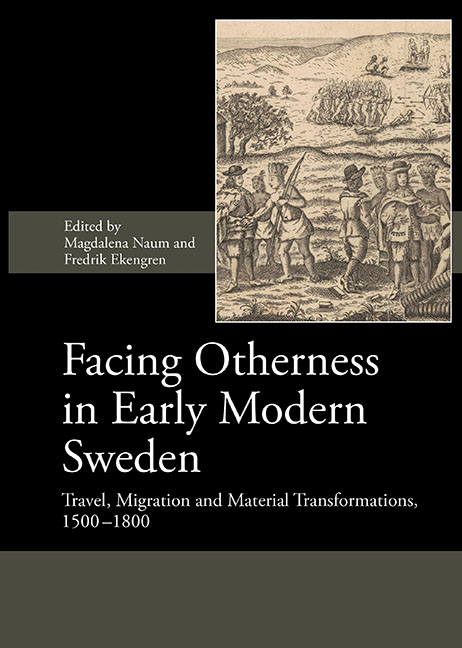Book contents
- Frontmatter
- Contents
- List of Illustrations
- List of Contributors
- Preface
- List of Abbreviations
- I Material Transformations
- II Migration and Neighbourly Interactions
- Introduction
- 6 Marrying “the Other”: Crossing Religious Boundaries in the Eastern Borderlands of the Kingdom of Sweden in the 17th Century
- 7 Ideas from Abroad: German Weavers as Agents of Large-Scale Cloth Production and a Continental Lifestyle in 17th-Century Sweden
- 8 Foreign Merchants in Early Modern Sweden: A Case of Intermarriage, Trade and Migration
- 9 Aspects of “British” Migration to Sweden in the 17th Century
- 10 Commodities, Consumption and Forest Finns in Central Sweden
- 11 Encountering “the Other” in the North – Colonial Histories in Early Modern Northern Sweden
- 12 Lapland's Taxation as a Reflection of “Otherness” in the Swedish Realm in the 17th and 18th Centuries: Colonialism, or a Priority Right of the Sami People?
- III Overseas Travel
- IV Conclusions
- Index
11 - Encountering “the Other” in the North – Colonial Histories in Early Modern Northern Sweden
from II - Migration and Neighbourly Interactions
Published online by Cambridge University Press: 23 July 2019
- Frontmatter
- Contents
- List of Illustrations
- List of Contributors
- Preface
- List of Abbreviations
- I Material Transformations
- II Migration and Neighbourly Interactions
- Introduction
- 6 Marrying “the Other”: Crossing Religious Boundaries in the Eastern Borderlands of the Kingdom of Sweden in the 17th Century
- 7 Ideas from Abroad: German Weavers as Agents of Large-Scale Cloth Production and a Continental Lifestyle in 17th-Century Sweden
- 8 Foreign Merchants in Early Modern Sweden: A Case of Intermarriage, Trade and Migration
- 9 Aspects of “British” Migration to Sweden in the 17th Century
- 10 Commodities, Consumption and Forest Finns in Central Sweden
- 11 Encountering “the Other” in the North – Colonial Histories in Early Modern Northern Sweden
- 12 Lapland's Taxation as a Reflection of “Otherness” in the Swedish Realm in the 17th and 18th Centuries: Colonialism, or a Priority Right of the Sami People?
- III Overseas Travel
- IV Conclusions
- Index
Summary
This chapter explores Swedish colonial and missionary projects in Sápmi (in present-day northern Sweden) in the 17th century, with a special focus on encounters with the indigenous Sami population, and the consequences for relationships between “Swedish” and “Sami” identity, culture and history today. Early modern colonial history in northern Sweden is in general afforded little recognition in Sweden. However, it is a history of great importance to many people today, with connections to present-day conflicts over land and cultural rights. Early modern views on the Sami have had a great impact on later representations of Sami identity, culture and religion. There is a need to analyse critically this history of “Us” and “Them” in the north. How can archaeology contribute to a more complex understanding of the colonial histories and encounters in Sápmi and northern Sweden in the early modern period?
The aim of this chapter is to discuss aspects of the early modern colonial histories and encounters in present-day northern Sweden, with special focus on the Sami populations in the north. The colonial history of northern Sweden is a contested and in many ways controversial field of study, with connections to present-day conflicts over land and cultural rights. This history is also connected with the understanding of the relationships between “Swedish” and “Sami” history and identity, and in recent decades also with debates on the use of the concept of indigeneity in Sweden. There is a great need further to examine Swedish colonial policies and practices in Sápmi, and the responses of the indigenous Sami population, as well as the larger ideological and political contexts of Swedish colonial expansion in the north. It is important to recognize and engage with the question of how archaeology can contribute to a more complex understanding of colonial histories and encounters in Sápmi in the early modern period.
Archaeologists and other scholars interested in exploring the early modern colonial history of Sápmi and northern Sweden, and its consequences and importance today, face many challenges concerning the connections between past and present, and the power relations involved in historical archaeology and the field of Sami archaeology. There are also many important issues concerning the roles and responsibilities of archaeology and archaeologists in Sápmi: for instance, in relation to current controversies concerning Sami indigenous land and cultural rights, which need to be considered and discussed by archaeologists working within this field.
- Type
- Chapter
- Information
- Facing Otherness in Early Modern SwedenTravel, Migration and Material Transformations 1500–1800, pp. 209 - 228Publisher: Boydell & BrewerPrint publication year: 2018
- 3
- Cited by

